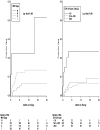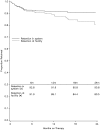Task shifting for scale-up of HIV care: evaluation of nurse-centered antiretroviral treatment at rural health centers in Rwanda
- PMID: 19823569
- PMCID: PMC2752160
- DOI: 10.1371/journal.pmed.1000163
Task shifting for scale-up of HIV care: evaluation of nurse-centered antiretroviral treatment at rural health centers in Rwanda
Abstract
Background: The shortage of human resources for health, and in particular physicians, is one of the major barriers to achieve universal access to HIV care and treatment. In September 2005, a pilot program of nurse-centered antiretroviral treatment (ART) prescription was launched in three rural primary health centers in Rwanda. We retrospectively evaluated the feasibility and effectiveness of this task-shifting model using descriptive data.
Methods and findings: Medical records of 1,076 patients enrolled in HIV care and treatment services from September 2005 to March 2008 were reviewed to assess: (i) compliance with national guidelines for ART eligibility and prescription, and patient monitoring and (ii) key outcomes, such as retention, body weight, and CD4 cell count change at 6, 12, 18, and 24 mo after ART initiation. Of these, no ineligible patients were started on ART and only one patient received an inappropriate ART prescription. Of the 435 patients who initiated ART, the vast majority had adherence and side effects assessed at each clinic visit (89% and 84%, respectively). By March 2008, 390 (90%) patients were alive on ART, 29 (7%) had died, one (<1%) was lost to follow-up, and none had stopped treatment. Patient retention was about 92% by 12 mo and 91% by 24 mo. Depending on initial stage of disease, mean CD4 cell count increased between 97 and 128 cells/microl in the first 6 mo after treatment initiation and between 79 and 129 cells/microl from 6 to 24 mo of treatment. Mean weight increased significantly in the first 6 mo, between 1.8 and 4.3 kg, with no significant increases from 6 to 24 mo.
Conclusions: Patient outcomes in our pilot program compared favorably with other ART cohorts in sub-Saharan Africa and with those from a recent evaluation of the national ART program in Rwanda. These findings suggest that nurses can effectively and safely prescribe ART when given adequate training, mentoring, and support. Please see later in the article for the Editors' Summary.
Conflict of interest statement
The authors have declared that no competing interests exist.
Figures
References
-
- World Health Organization. Towards universal access: scaling up priority HIV/AIDS interventions in the health sector: progress report. Geneva: World Health Organization; 2008. Available: http://www.who.int/hiv/pub/towards_universal_access_report_2008.pdf. Accessed 2 September 2008.
-
- Van Damme W, Kober K, Laga M. The real challenges for scaling up ART in sub-Saharan Africa. AIDS Patient Care STDS. 2006;20:653–656. - PubMed
-
- World Health Organization. Taking stock: health worker shortages and the response to AIDS. Geneva: World Health Organization; 2006. Available: http://www.who.int/hiv/toronto2006/takingstockttr.pdf. Accessed 2 September 2008.
-
- World Health Organization. Task shifting: rational redistribution of task among health workforce teams: global recommendations and guidelines. Geneva: World Health Organization; 2008. Available: http://www.who.int/hiv/healthsystems/TTR-TaskShifting.pdf. Accessed 2 September 2008.
-
- Samb B, Celletti F, Holloway J, Van Damme W, De Cock KM, et al. Rapid expansion of the health workforce in response to the HIV Epidemic. N Engl J Med. 2007;357:2510–2514. - PubMed
Publication types
MeSH terms
Substances
LinkOut - more resources
Full Text Sources
Medical
Research Materials



